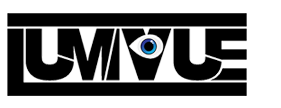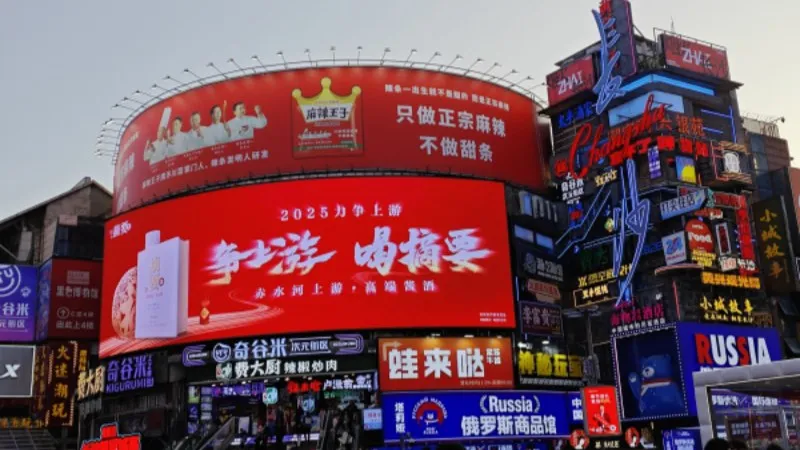
Have you ever walked past a large format LED screen and been completely captivated by the visuals? Large LED screens are designed to grab attention and make an impact.
From massive billboards to event backdrops, they’re everywhere, and for good reason. But what makes these screens so effective?
In this post, we’ll dive into the features that set them apart, explore their uses, and help you figure out how to choose the right one for your needs.
1. What is a Large Format LED Screen?
A large format LED screen is a high-resolution display technology designed to deliver stunning visuals on a grand scale. These screens are composed of numerous light-emitting diodes (LEDs) that work together to create vibrant, high-quality images and videos.
Unlike traditional displays, large format LED displays are modular, allowing them to be customized to fit various sizes and shapes, making them ideal for both indoor and outdoor applications.
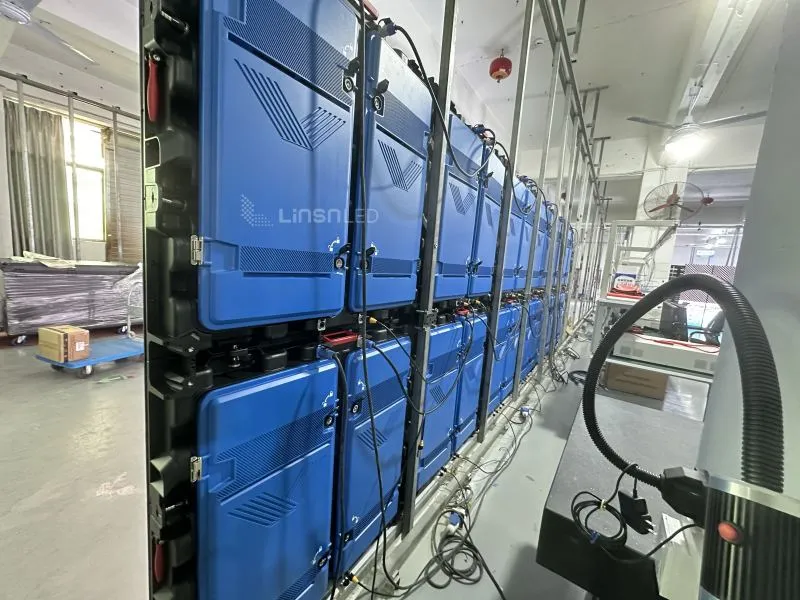
MA960 Modular Design
The term big LED screen or giant LED screen often refers to the same technology, emphasizing the impressive size and visual impact of these displays.
Whether used for advertising, entertainment, or information dissemination, giant LED displays have become a cornerstone of modern visual communication.
2. Types of Large Format LED Screens
When it comes to large format LED screens, understanding the different types is crucial for selecting the right display for your needs. Here are the six most important types of large format LED displays, each designed for specific applications and environments:
2.1 Indoor LED Screens
Indoor LED screens are perfect for controlled environments like conference rooms, retail stores, amusement, and theaters. These screens offer high resolution and brightness, ensuring clear and vibrant visuals even in well-lit spaces. They are ideal for presentations, advertising, and entertainment.
Key Features:
(1) High pixel density for close-up viewing
(2) Energy-efficient and low heat emission
(3) Customizable sizes and shapes
2.2 Outdoor LED Screens
Outdoor LED screens are built to withstand harsh weather conditions, making them ideal for billboards, stadiums, and public events. These screens feature high durability, weatherproofing, and superior brightness to remain visible even in direct sunlight.
Key Features:
(1) Weather-resistant and dustproof (IP65/IP67 rated)
(2) High brightness (5,000–10,000 nits) for outdoor visibility
(3) Long lifespan and low maintenance
2.3 Rental LED Screens
Rental LED screens are modular and portable, making them the go-to choice for temporary events like concerts, trade shows, and exhibitions. They are easy to assemble and disassemble, offering flexibility for various event setups.
Key Features:
(1) Lightweight and easy to transport
(2) Quick installation and dismantling
(3) Durable construction for repeated use
2.4 Transparent LED Screens
Transparent LED screens allow light to pass through, creating a see-through effect. These screens are often used in retail storefronts, museums, and architectural installations to combine digital content with physical visibility.
Key Features:
(1) High transparency (up to 70–90%)
(2) Lightweight and slim design
(3) Ideal for creative advertising and displays
2.5 Fine Pitch LED Screens
Fine pitch LED screens have a smaller pixel pitch, delivering ultra-high resolution for close-up viewing. These screens are commonly used in control rooms, broadcast studios, and high-end retail displays.
Key Features:
(1) Pixel pitches as low as P1.25 for crystal-clear visuals
(2) Seamless and bezel-free design
(3) Perfect for detailed content and close-range viewing
2.6 Curved LED Screens
Curved LED screens are designed to wrap around structures or create immersive viewing experiences. They are often used in theaters, planetariums, and large-scale events to enhance audience engagement.
Key Features:
(1) Customizable curvature for unique designs
(2) Enhanced depth and immersion
(3) Ideal for 360-degree viewing experiences
3. Key Features of Large Format LED Displays
Large format LED displays are changing the way we communicate visually. Whether you’re looking for a big LED screen for ads or a giant LED display for an event, it’s important to know what makes them special. Here are six key features that set large format LED screens apart:
3.1 High Resolution and Pixel Density
Large format LED displays deliver sharp, detailed visuals with high pixel density. Pixel pitches range from P1.25 to P10, ensuring clarity even from close viewing distances.
These screens are perfect for environments where detail is crucial, such as control rooms, retail spaces, and live events, providing excellent image quality no matter how close you are.
3.2 Superior Brightness and Contrast
With brightness levels between 1,000 and 10,000 nits, large format LED displays are visible even in bright sunlight. The high contrast ratios allow for rich, vibrant colors and deep blacks.
This makes them ideal for both indoor and outdoor use, ensuring stunning visuals that grab attention in any lighting condition, whether it’s a sunny day or a dark room.
3.3 Seamless and Modular Design
The modular nature of these displays means they can be seamlessly combined to create a larger, uninterrupted screen. There are no visible bezels or gaps, which ensures a smooth viewing experience.
They can also be customized to fit any size or shape, offering flexibility for different applications, whether it’s a huge event screen or a smaller, more unique installation.
3.4 Energy Efficiency
Large format LED displays are designed to use less energy while still providing high performance. This makes them a cost-effective option for long-term use.
Their low power consumption not only reduces electricity bills but also makes them a more eco-friendly choice, aligning with sustainability goals while maintaining top-quality performance.
3.5 Durability and Longevity
These displays are built to withstand harsh environments. They’re resistant to dust, water, and UV rays, making them perfect for both indoor and outdoor installations.
Whether it’s extreme weather conditions or heavy-duty usage, these screens are designed for long-lasting performance, minimizing the need for frequent maintenance or replacements.
3.6 Advanced Control and Connectivity
Large format LED displays come with advanced control systems, making content management simple. They offer seamless connectivity, allowing easy integration with other technologies like IoT and AI.
This makes real-time updates and remote monitoring possible, while also enabling interactive and dynamic displays for a more engaging user experience.
4. Applications of Large Format LED Display
Large format LED displays are changing the game in how we share information and connect with audiences. Their flexibility and stunning visuals make them a go-to solution for countless industries. Here’s a look at where these powerful screens are making a big impact:
4.1 Advertising and Digital Signage
When it comes to grabbing attention, large format LED displays are unbeatable. You’ll spot them in:
Billboards: Bright, bold screens light up highways and city centers, making ads impossible to miss.
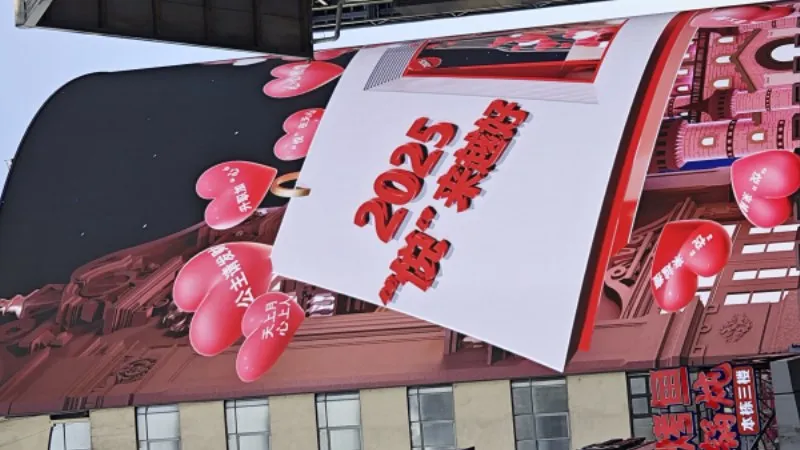
Retail Stores: Indoor displays showcase products and deals, turning shoppers into buyers.
Transit Hubs: Airports and train stations use LED screens for ads and helpful directions.
These screens are perfect for delivering eye-catching, real-time content that keeps audiences engaged.
4.2 Entertainment and Events
From concerts to sports games, large format LED displays are the star of the show. They’re used for:
Concerts and Festivals: Giant screens bring live performances to life with stunning visuals and animations.
Sports Stadiums: Fans never miss a moment with screens showing replays, scores, and ads.
Theaters and Arenas: Indoor displays create immersive backdrops that wow audiences.
With vibrant colors and customizable designs, these screens make every event unforgettable.
4.3 Corporate and Education
In offices and schools, large format LED displays are transforming how we work and learn. They’re used for:
Conference Rooms: Crystal-clear screens make presentations and video calls more effective.
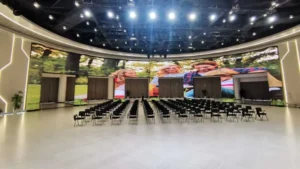
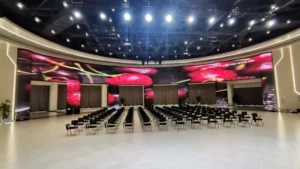
Boardrooms: Displays turn complex data into easy-to-understand visuals for better decision-making.
Classrooms: Interactive screens bring lessons to life, making learning more engaging.
These displays are all about improving communication and collaboration, whether in the boardroom or the classroom.
4.4 Control Rooms and Command Centers
Industries like transportation, energy, and security depend on large format LED displays to stay on top of operations. They’re used for:
Real-Time Monitoring: Airports and traffic centers rely on screens to track everything in real time.
Data Visualization: Power plants and utilities use displays to show critical information at a glance.
Surveillance: Security centers monitor multiple feeds simultaneously for enhanced safety.
Their reliability and clarity make them a must-have for 24/7 operations.
4.5 Retail and Hospitality
In stores, hotels, and restaurants, large format LED displays are all about creating unforgettable experiences. They’re used to:
Storefronts: Transparent screens combine ads with window displays, catching the eye of passersby.
Hotels and Restaurants: Displays show menus, promotions, and event schedules in style.
Shopping Malls: Large screens turn malls into vibrant, engaging spaces for shoppers.
These displays don’t just attract customers—they keep them coming back.
4.6 Public Spaces and Community Engagement
Large format LED displays are also transforming public areas by:
City Centers: Outdoor screens share news, events, and community messages with everyone.
Parks and Plazas: Giant displays host public events and entertainment, bringing people together.
Museums and Galleries: Indoor screens add interactive content to exhibits, making them more engaging.
They’re helping create modern, connected spaces that inform and inspire.
From advertising to education, large format LED displays are versatile tools that deliver stunning visuals and powerful impact. Whether you need a big LED screen for events or a high-resolution display for corporate use, these screens are the perfect solution for making a lasting impression.
Curious about the top 10 largest LED displays in the World? Click here to explore this exciting article and discover the jaw-dropping, record-breaking screens that are redefining visual experiences across the globe!
5. Key Factors to Consider When Choosing a Large LED Screen
When choosing a large LED screen, there are a few key things to keep in mind to make sure you pick the best one for your needs. Here’s a simplified breakdown:
(1) Screen Size and Resolution
Make sure the screen is big enough for your space. Larger screens are great for visibility from far away, but resolution matters too. Higher resolution means sharper images, which is especially important for close-up viewing. Look for a screen with good resolution for the best clarity, whether you’re using it for advertising or events.
(2) Brightness
If the LED screen will be used outdoors or in bright places, you’ll need one that’s bright enough to be visible even in direct sunlight. Higher brightness ensures the display is easy to see, whether it’s for an outdoor billboard or an indoor presentation.
(3) Viewing Angle
Think about where people will be standing or sitting in relation to the screen. A wide viewing angle ensures that everyone can see the screen clearly, without the image becoming blurry or distorted from the side. This is important for public spaces like shopping malls or stadiums.
(4) Energy Efficiency
You want an LED screen that doesn’t drain too much power, especially if it will be running for long hours. Energy-efficient screens help save on electricity costs and are more eco-friendly, making them a smart choice for long-term use.
(5) Durability
If you’re using the screen outdoors or in harsh environments, look for one that’s durable and weather-resistant. A good LED screen should be able to handle extreme temperatures, rain, dust, and sunlight without breaking down easily.
(6) Ease of Installation and Maintenance
Consider how easy it will be to install and maintain the screen. A modular design makes it easier to set up and maintain, and you’ll want a screen that allows for simple repairs without much hassle.
(7) Connectivity and Control
Make sure the screen can easily connect with your devices, whether it’s for real-time content updates or remote control. Look for screens that support multiple input options like HDMI, Wi-Fi, and Ethernet, so you can manage the display smoothly.
(8) Cost and Value
While you may have a budget to stick to, it’s important to balance cost with quality. A more expensive screen might offer better resolution, durability, and features, but always choose one that gives you the most value for your money based on your needs.
By keeping these factors in mind, you’ll be able to choose a large LED screen that meets your specific requirements and performs well over time.
6. Buy VS Rent a Giant LED Screen
When deciding whether to buy or rent a giant LED screen, it’s important to consider how long you’ll use it, your budget, and the features you need. Here’s a quick comparison to help you choose the best option for your needs.
| Factor | Buy a Giant LED Screen | Rent a Giant LED Screen |
| Initial Cost | High upfront cost, but no ongoing rental fees. | Lower upfront cost, with recurring rental fees. |
| Long-Term Use | Best for ongoing or permanent use. | Ideal for short-term or one-time events. |
| Customization | Full control over size, resolution, and features. | Limited customization options, typically set configurations. |
| Maintenance | Ongoing responsibility for maintenance and repairs. | Maintenance typically handled by the rental company. |
| Storage | Need space for storage if not in use (for portable models). | No need for storage; the rental company manages this. |
| Flexibility | Fixed, non-adjustable once purchased. | Flexible; can rent different sizes and types as needed. |
| Upgrade Options | Can upgrade when needed, but incurs additional costs. | Easy to switch to newer models when renting. |
| Total Cost Over Time | More cost-effective in the long run if used frequently. | Can become expensive for long-term use. |
Buying is better for long-term or frequent use, giving you full control but with higher upfront costs and responsibility for maintenance.
Renting is great for short-term needs, with lower initial costs and flexibility, but can become more expensive if used over a long period.
Pick the option that best fits your usage and budget.
7. The Future of Big LED Screens
The future of big LED screens is looking bright, with constant advancements in technology and new ways to use them. These screens are becoming even more powerful, flexible, and accessible for businesses and events. Here’s what the future holds:
(1) Better Image Quality
The resolution of LED screens will continue to improve, offering sharper, clearer images even from far away. Expect more screens with 4K and 8K resolutions, which will make visuals look even more stunning for both indoor and outdoor use.
(2) Thinner and Lighter Screens
LED screens are becoming thinner and lighter, making them easier to install and move around. This is great for events, as screens can now fit into more spaces and be transported with less hassle.
(3) Flexible and Curved Displays
Soon, we’ll see more flexible LED screens that can curve or bend. These will allow for more creative installations, like wrapping displays around columns or creating immersive environments for events.
(4) Smarter Technology
Big LED screens are getting smarter with better AI integration and interactive features. This means screens will be able to adjust content based on the audience, environment, or time of day, making them more dynamic and personalized.
(5) Energy Efficiency
As technology improves, LED screens are becoming more energy-efficient, using less power while delivering brighter, clearer visuals. This makes them more eco-friendly and reduces operating costs for businesses.
(6) Outdoor Usability
With improved durability, future big LED screens will handle harsh outdoor environments better, staying bright and clear even in direct sunlight or extreme weather conditions.
The future of big LED screens is full of exciting possibilities. With better image quality, smarter technology, and more flexible designs, these screens will continue to transform how we interact with visuals in everyday life, making them a great investment for both short-term events and long-term use.
8. FAQs
Large format LED screens can range from 50 inches to over 300 inches diagonally. The size will depend on the specific needs of the application, whether it’s for outdoor billboards, stadium displays, or indoor digital signage.
Large format LED screens are specifically designed for large-scale applications. They offer higher brightness, larger sizes, and greater viewing distances compared to smaller LED displays, making them ideal for public spaces or outdoor use.
Yes, many large format LED screens are designed for outdoor use and come with high brightness and weather-resistant features. Be sure to choose a screen that’s specifically rated for outdoor environments.
To maintain your large LED screen, keep it clean, check for overheating, and ensure it’s placed in an environment with stable temperature and humidity. Regularly inspect the wiring and connections, and update the software as needed.
Large format LED screens can have a higher upfront cost, but they are cost-effective in the long run if used regularly, especially for permanent installations like digital signage or outdoor billboards. The cost varies based on size, resolution, and features.
The size depends on the viewing distance and space. Larger screens are ideal for open areas with longer viewing distances, while smaller screens are more suitable for indoor use or close-range viewing.
9. Conclusion
The large format LED screen delivers stunning visuals that capture attention and leave a lasting impact, making them a powerful tool for businesses and events.
Whether you need a large format LED screen or a more compact solution depends on your specific goals, space, and budget.
By considering factors like resolution, durability, and purpose, you can choose the right display to elevate your brand, engage your audience, and create unforgettable experiences.
 Need Expert Advice?
Need Expert Advice?
Choosing the right LED display can feel overwhelming — but you don’t have to do it alone. Our team at Lumivue is here to guide you with personalized recommendations, local support, and reliable solutions that fit your project.

